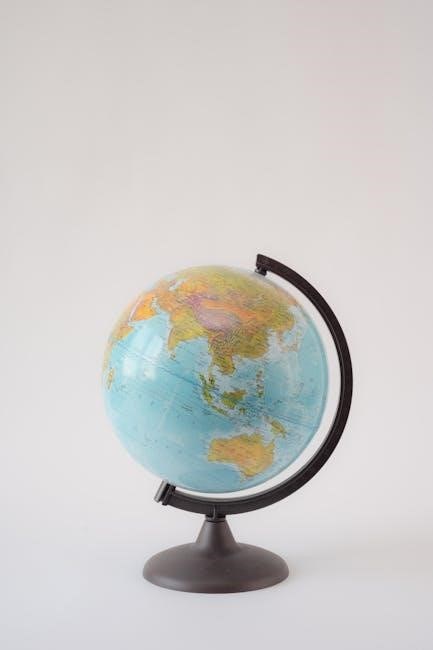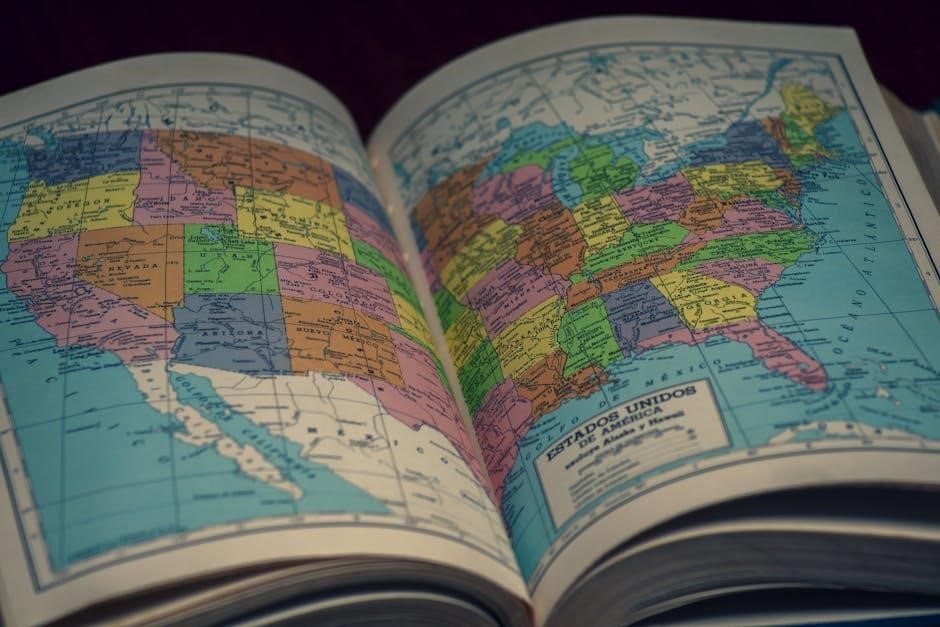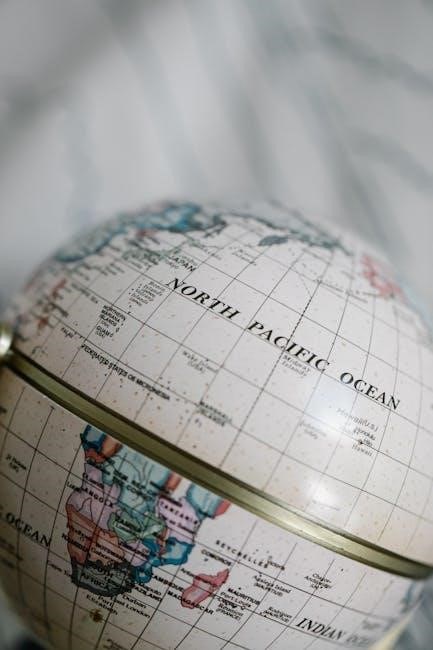World War I (1914-1918) was a global conflict involving major powers‚ causing unprecedented destruction and societal change. It resulted in millions of casualties and reshaped global politics.
Overview of World War I
World War I (1914-1918) was a global conflict involving major powers divided into the Allied and Central Powers. It began in Europe but spread to colonies and the United States‚ causing unprecedented destruction. The war introduced trench warfare‚ new technologies‚ and massive casualties. Key events included the assassination of Archduke Franz Ferdinand‚ the invasion of Belgium‚ and major battles like the Somme and Verdun. The war marked the end of empires‚ reshaped global politics‚ and set the stage for future conflicts‚ leaving a lasting impact on society and international relations.
Significance of Studying World War I
Studying World War I is crucial for understanding its profound impact on modern society‚ global politics‚ and international relations. It highlights the consequences of militarism‚ alliances‚ imperialism‚ and nationalism‚ offering lessons on conflict prevention. The war reshaped economies‚ led to the collapse of empires‚ and influenced the rise of new nations. Analyzing its causes‚ key events‚ and outcomes provides insights into diplomacy‚ warfare‚ and societal change‚ helping us learn from history to avoid future conflicts and foster global cooperation.

Causes of World War I
World War I arose from a combination of militarism‚ alliances‚ imperialism‚ and nationalism‚ creating a volatile environment. The assassination of Archduke Franz Ferdinand triggered the conflict.
Militarism: The Build-Up of Military Forces
Militarism‚ the glorification of military power‚ fueled tensions among European nations. Countries engaged in arms races‚ increasing military spending and expanding armed forces. This buildup created suspicion and competition‚ making war seem inevitable. Nations believed a strong military was essential for survival and prestige. The rise of conscription and advanced weaponry escalated tensions further. This environment heightened the likelihood of conflict‚ as smaller disputes could quickly escalate into larger wars‚ contributing to the outbreak of World War I.
Alliances: The Complex System of Agreements
The alliance system divided Europe into two powerful groups: the Triple Entente (France‚ Britain‚ Russia) and the Triple Alliance (Germany‚ Austria-Hungary‚ Italy). These mutual defense agreements created a volatile environment‚ as localized conflicts could escalate into broader wars. When Austria-Hungary declared war on Serbia‚ the alliances triggered a chain reaction‚ drawing more nations into the conflict; This rigid system fostered competition and mistrust‚ leaving little room for neutrality and transforming a regional dispute into a global war.
Imperialism: Competition for Colonies and Resources
Imperialism fueled tensions as European nations competed for colonies and resources‚ particularly in Africa and the Middle East. The scramble for territories created economic and political rivalries‚ with Germany challenging France and Britain’s dominance. Events like the Moroccan Crises highlighted these tensions‚ as nations sought to expand their empires. This competition contributed to the complex system of alliances and heightened nationalism‚ making conflicts over colonies a catalyst for broader European tensions and ultimately contributing to the outbreak of World War I.
Nationalism: The Rise of National Pride and Tensions
Nationalism intensified tensions in the early 20th century‚ as ethnic groups within multi-ethnic empires sought independence. The Balkans‚ particularly‚ became a hotspot of nationalist sentiment‚ with groups like the Black Hand radicalizing individuals. The assassination of Archduke Franz Ferdinand exemplified this extremism. National pride and the belief in national superiority pushed countries to prioritize their interests over diplomacy‚ fostering an environment where war seemed inevitable. This mindset contributed to aggressive foreign policies and alliances‚ escalating tensions into a global conflict.

Key Events Leading to World War I
The complex system of alliances‚ militarism‚ imperialism‚ and nationalism created a volatile environment‚ with events like the Balkan Wars and Moroccan Crises heightening tensions.
The Assassination of Archduke Franz Ferdinand
On June 28‚ 1914‚ Archduke Franz Ferdinand‚ heir to the Austro-Hungarian throne‚ was assassinated in Sarajevo by Gavrilo Princip‚ a Bosnian Serb member of the Black Hand group. This event triggered a chain reaction‚ leading Austria-Hungary to issue an ultimatum to Serbia. The assassination is widely regarded as the immediate cause of World War I‚ highlighting the volatile mix of nationalism and imperialism in Europe at the time. It set off a series of diplomatic crises and military mobilizations that escalated into global conflict.
The Invasion of Belgium and Britain’s Entry into the War
In August 1914‚ Germany invaded neutral Belgium as part of the Schlieffen Plan to quickly capture Paris. This violation of Belgium’s neutrality compelled Britain‚ bound by a treaty to defend Belgian sovereignty‚ to declare war on Germany. The invasion caused widespread destruction and a massive refugee crisis‚ drawing Britain into the conflict. This event marked a significant escalation of the war‚ highlighting the clash of military strategies and national interests that fueled the conflict’s expansion.
World War I saw the introduction of devastating new weapons that transformed modern warfare. Tanks were first deployed by the British in 1916 to break through trench lines‚ offering protection from machine-gun fire and barbed wire. Poison gas‚ initially used by Germany in 1915‚ caused severe injuries and panic‚ leading to widespread terror. Both sides adopted gas warfare‚ prompting the development of gas masks and other defenses. These innovations reflected the industrial scale of the conflict and the brutal tactics employed to gain an advantage on the battlefield.

Major Battles of World War I
Key battles like the Somme and Verdun showcased the brutality of trench warfare‚ with massive casualties and stalemate‚ defining the war’s devastating nature.
The Battle of the Somme
The Battle of the Somme (1916) was one of the bloodiest battles in World War I‚ lasting 141 days. It began on July 1‚ 1916‚ with massive casualties due to relentless artillery and trench warfare. Over one million soldiers were killed or wounded‚ highlighting the horrors of modern warfare. The British introduced tanks for the first time‚ but the battle remained a stalemate. The Somme became a symbol of the war’s futility and the immense human cost of industrialized combat.
The Battle of Verdun
The Battle of Verdun (1916) was a brutal and symbolic conflict between French and German forces‚ lasting 303 days. It became a test of endurance‚ with both sides suffering heavy casualties. The battle saw the introduction of new technologies like poison gas and intense artillery bombardments. Despite significant losses‚ the French held their ground‚ making Verdun a symbol of resistance. The battle highlighted the futility of trench warfare and the immense human cost of World War I.

The Home Front During World War I
World War I transformed civilian life‚ with rationing‚ propaganda‚ and women entering the workforce. Societies mobilized resources‚ enduring hardships while supporting the war effort.
Rationing and Conservation Efforts
Rationing became essential during World War I as governments diverted resources to the war effort. Civilians faced shortages of food‚ fuel‚ and other essentials. Governments implemented strict controls‚ distributing ration cards to ensure fair access. People were encouraged to conserve resources‚ with slogans like “Make Do and Mend” promoting frugality. These measures aimed to sustain morale and ensure supplies for both soldiers and civilians‚ though they often led to widespread hardship and economic strain.
The Role of Propaganda in Shaping Public Opinion
Propaganda played a crucial role in World War I‚ shaping public opinion and maintaining morale. Governments used posters‚ films‚ and media to promote patriotism and support for the war effort. Messages often portrayed the enemy as brutal and emphasized the necessity of victory. Propaganda also encouraged civilians to contribute through rationing and conservation. It fostered unity and justified sacrifices‚ while often distorting realities of the war. This tool was vital in sustaining public support and mobilizing societies for the conflict.
Women’s Contributions to the War Effort
During World War I‚ women played a vital role in supporting the war effort. With men away fighting‚ women entered the workforce in unprecedented numbers‚ taking on roles in factories‚ agriculture‚ and public services. They also joined voluntary organizations‚ providing aid to soldiers and civilians; Women’s contributions were essential to maintaining production and morale‚ challenging traditional gender roles and paving the way for future social changes. Their efforts were crucial in sustaining societies during the conflict.

Economic Mobilization and War Production
World War I drove economies to shift from consumer goods to war materials‚ with factories producing weapons and supplies. Governments implemented rationing and price controls to manage resources.
Shift from Consumer Goods to War Materials
During World War I‚ economies transitioned from producing consumer goods to manufacturing war materials. Factories shifted focus to weapons‚ ammunition‚ and military equipment‚ driving innovation in production. Governments implemented rationing and price controls to manage resource shortages. This shift boosted economies temporarily but led to inflation and debt. Women entered the workforce in unprecedented numbers‚ replacing men who had enlisted. The demand for resources spurred advancements in manufacturing and logistics‚ laying the groundwork for future industrial progress.
The Impact of Rationing and Price Controls
Rationing and price controls during World War I managed resource shortages‚ ensuring fair distribution of essentials like food and fuel. Civilians faced hardships‚ including limited supplies and rising costs. These measures aimed to support the war effort but caused economic strain and societal changes. Labor movements gained momentum‚ and women’s roles expanded as they entered the workforce. The government’s efforts to stabilize the economy led to long-term shifts in societal norms and expectations‚ reshaping daily life during and after the war.
Women in the Workforce
During World War I‚ women entered the workforce in unprecedented numbers‚ filling roles left vacant by men in the military. They took on jobs in factories‚ agriculture‚ and transport‚ facing new challenges but gaining financial independence. This shift challenged traditional gender roles and significantly contributed to the push for women’s suffrage‚ leaving a lasting impact on society and paving the way for future gender equality movements.

The United States’ Involvement in World War I
The U.S. initially maintained neutrality but entered the war in 1917 due to Germany’s unrestricted submarine warfare and the sinking of the Lusitania.
Initial Neutrality and the Sinking of the Lusitania
The United States initially maintained neutrality in World War I‚ avoiding involvement in European conflicts. However‚ public opinion shifted after the sinking of the passenger ship Lusitania by a German U-boat in 1915‚ which killed over 1‚000 civilians‚ including 128 Americans. This event outraged the U.S. population and strained relations with Germany‚ marking a turning point in America’s stance toward the war. The tragedy played a significant role in shifting U.S. policy and eventual entry into the conflict.
Unrestricted Submarine Warfare and the Zimmermann Telegram
Germany’s resumption of unrestricted submarine warfare in 1917 targeted all ships‚ including neutral ones‚ to cut off Britain’s supplies. This led to the sinking of American merchant ships‚ escalating tensions.
The Zimmermann Telegram‚ sent by Germany to Mexico‚ urged an attack on the U.S. if it entered the war. Intercepted by Britain and shared with the U.S.‚ it further strained relations‚ pushing America closer to war.
American Contributions to the Allied Victory
The United States played a pivotal role in the Allied victory‚ deploying over 2 million soldiers and providing crucial supplies. The American Expeditionary Forces significantly impacted battles like the Argonne Forest‚ shifting the war’s momentum.
The U.S. also shifted its economy to war production‚ manufacturing weapons and supplies. Citizens supported the effort through rationing and conservation‚ while women entered the workforce in unprecedented numbers‚ aiding the war effort and societal change.

The Treaty of Versailles
The Treaty of Versailles ended World War I in 1919‚ imposing harsh penalties on Germany‚ including the War Guilt Clause and massive reparations‚ fueling resentment and future conflicts.
The War Guilt Clause and Reparations
The Treaty of Versailles included the War Guilt Clause‚ which blamed Germany for causing World War I and its damages. This led to severe reparations‚ totaling 132 billion gold marks‚ imposed on Germany. The economic burden caused hyperinflation and widespread resentment among Germans. The clause and reparations were deeply unpopular in Germany‚ fostering a sense of injustice and contributing to the rise of Adolf Hitler and the Nazi Party. This provision is often seen as a factor leading to World War II.
The Mandate System and Redrawing National Borders
The Treaty of Versailles introduced the Mandate System‚ allowing the League of Nations to administer former territories of defeated empires. Regions like the Middle East and Africa were divided among Allied powers‚ with Britain and France gaining control over Ottoman territories. National borders were redrawn‚ creating new states and reshaping political landscapes. This redrawing often ignored ethnic and cultural boundaries‚ leading to long-term tensions. The system reflected the victors’ interests and laid the groundwork for future conflicts‚ including World War II.
The Legacy of the Treaty and Its Impact on Future Conflicts
The Treaty of Versailles imposed harsh penalties on Germany‚ fostering resentment and economic hardship. The War Guilt Clause and heavy reparations fueled German nationalism and contributed to the rise of Adolf Hitler. The treaty’s failure to establish a stable peace led to widespread dissatisfaction‚ creating an environment in which World War II could emerge. Its emphasis on self-determination also redrawn borders‚ often ignoring ethnic divisions‚ leading to ongoing tensions in regions like the Middle East and Eastern Europe.

The Human Cost of World War I
World War I caused immense suffering‚ with 9 million soldiers and 6 million civilians killed. Soldiers endured psychological trauma‚ while civilians faced widespread hardship and displacement.
Casualties and the Psychological Toll on Soldiers
World War I resulted in devastating casualties‚ with over 9 million soldiers killed and millions more wounded. The psychological toll was immense‚ as soldiers endured traumatic conditions in trenches‚ leading to shell shock and long-term mental health issues. The constant exposure to violence and loss deeply affected their well-being‚ leaving lasting scars. Many struggled to reintegrate into society after the war‚ highlighting the profound human cost of the conflict.
The Impact of Trench Warfare on Soldiers’ Lives
Trench warfare exposed soldiers to harsh conditions‚ including flooding‚ pests‚ and disease. Prolonged exposure to danger and discomfort led to physical and psychological trauma. The brutal environment caused widespread mental health issues‚ symbolizing the war’s brutal and static nature.
Civilian Suffering and the Refugee Crisis
World War I caused immense civilian suffering‚ with widespread displacement and loss of livelihoods. The invasion of Belgium led to a massive refugee crisis‚ as millions fled their homes. Civilians endured food shortages‚ economic hardship‚ and emotional strain from losing loved ones. The war accelerated social changes‚ including labor movements and the push for women’s suffrage‚ as societies coped with the devastating impact of the conflict on daily life and families.

Long-Term Consequences of World War I
World War I led to the collapse of empires‚ the rise of new nations‚ and a reshaped global political landscape. The Treaty of Versailles created economic instability and political tensions‚ fostering the rise of fascist and nationalist movements that contributed to World War II.
The Collapse of Empires and the Rise of New Nations
World War I led to the dissolution of several empires‚ including the Ottoman‚ Austro-Hungarian‚ German‚ and Russian empires. The Treaty of Versailles redrew national borders‚ creating new nations like Poland and Czechoslovakia. The Mandate System granted Britain and France control over former Ottoman territories‚ while the Russian Empire fragmented into the Soviet Union. This reshuffling of territories and the rise of nationalist movements set the stage for future conflicts and fundamentally altered the global political landscape.
The Reshaping of Global Politics and Economies
World War I profoundly reshaped global politics and economies. The war’s end marked the decline of European dominance and the rise of the United States and Japan as major powers. Economically‚ nations faced inflation‚ debt‚ and industrial shifts‚ while colonies began questioning imperial rule. The Treaty of Versailles imposed harsh penalties on Germany‚ fostering resentment. Additionally‚ the war accelerated the spread of socialist movements and nationalism‚ further destabilizing global stability and setting the stage for future economic and political shifts worldwide.
The Pave the Way for World War II
World War I’s aftermath created conditions that led to World War II. The Treaty of Versailles imposed harsh reparations on Germany‚ fostering economic hardship and resentment. The rise of fascist leaders like Hitler exploited these grievances‚ promising restoration of national pride. The war also destabilized global power structures‚ leading to the collapse of empires and the rise of new ideologies. These factors‚ combined with unresolved tensions‚ set the stage for another devastating conflict‚ making World War I a pivotal event in the lead-up to World War II.
